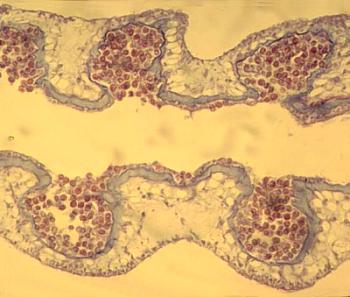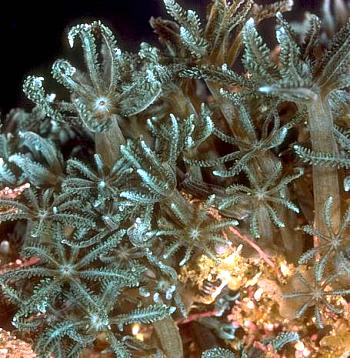

Zooxanthellae in Cnidarians
PHOTO
UPPER: Section through an oral tentacle of Xenia showing the sacs along the tentacles packed full of zooxanthellae. LOWER: Colony of the soft coral Xenia. Note the 'bumps' along the oral tentacles which are the outward sign of the sacs full of zooxanthellae. PHOTOS: Bill Rudman.
Zooxanthellae are symbiotic single-celled plants which are related to the free-living planktonic dinoflagellates. They live in the tissues of many marine invertebrate animals, including Giant Clams, nudibranchs and flatworms, but they are best known for their association with cnidarians, and in particular the reef-forming corals, which would be unable to build their calcium carbonate skeletons without the nutrients provided by their zooxanthellae.
To illustrate this cnidarian - zooxanthellae symbiosis, here are photos of zooxanthellae in the soft coral Xenia. Because the zooxanthellae are plants, they need sunlight to photosynthesise, so they need to find a part of their host animal which is not regularly shaded, or so far beneath the skin, that sunlight can't penetrate. In Xenia they live in the oral tentacles which during the day are fully extended, soaking up the sunlight.
For further information go to the following pages: •Solar Powered Sea Slugs
•Zooxanthellae - what are they?
•Zooxanthellae - in nudibranchs
•Zooxanthellae - references
Rudman, W.B., 2000 (October 10) Zooxanthellae in Cnidarians. [In] Sea Slug Forum. Australian Museum, Sydney. Available from http://www.seaslugforum.net/factsheet/zoox2
